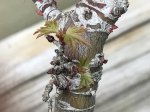markyscott
Imperial Masterpiece
I have little doubt.
I just have trouble with the notion that good trees means that particular rituals are necessary/sensible and relevant to having/producing good trees. It pays to understand why, IMHO.
I only offer what I was taught and what I do myself when repotting. I've no idea which part of the technique is most important and which, if removed, would give you the same result. I doubt there is any scientific support for tapping down the soil surface with a trowel. Using one does compact the top soil a bit by rotating the grains toward a closest packed configuration which reduces the porosity. The effect is probably small and most pronounced near the soil surface - I doubt it has much impact deeper in the pot. Does it matter? Probably not hugely, but it does help produce a nice flat soil surface, which aids with watering and is attractive to my eye. Can you achieve the effect some other way? Probably - I often use my hand to similar effect, particularly on bigger pots - sometimes skipping the trowel all together. Will the plants grow as well if you don't do it? Probably - but we won't know unless someone does a study. For me, I just live with the wonder and do it anyway. If nothing else, I like the way it looks when I'm done.
Last edited:



